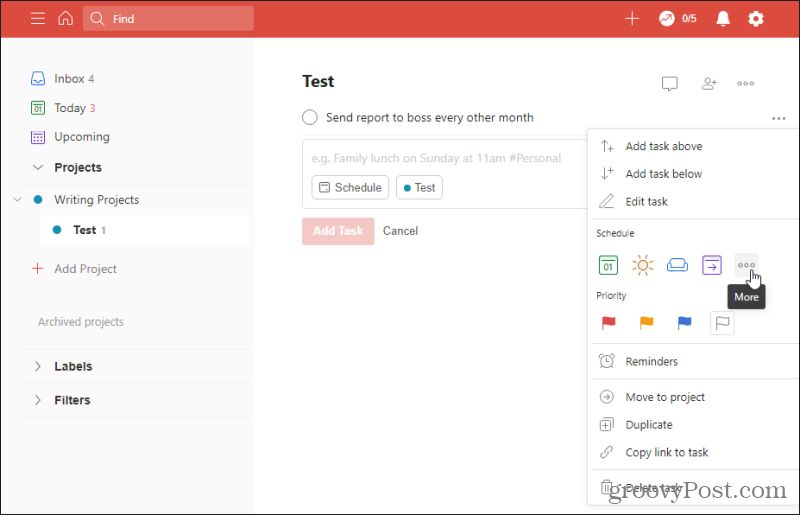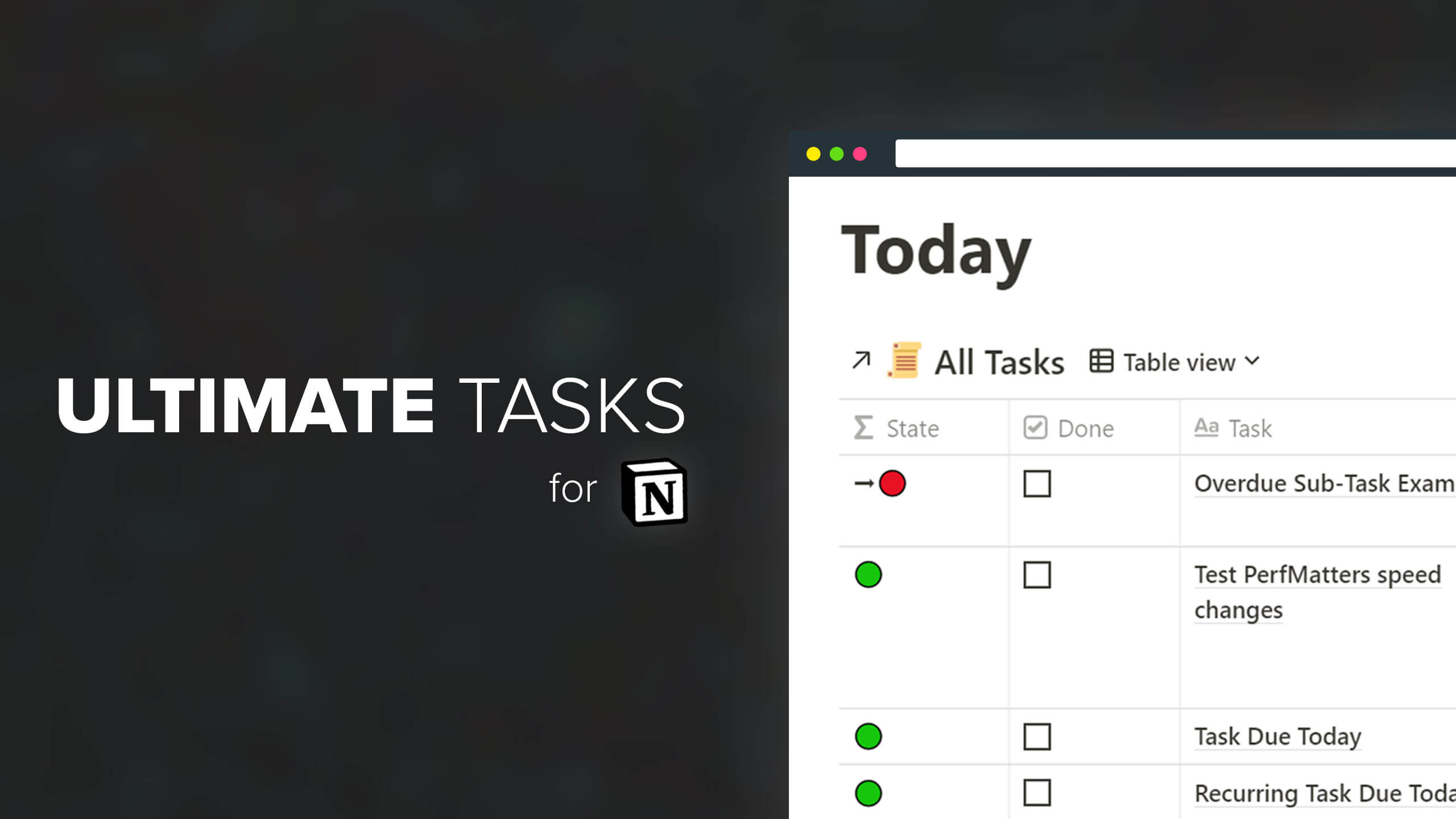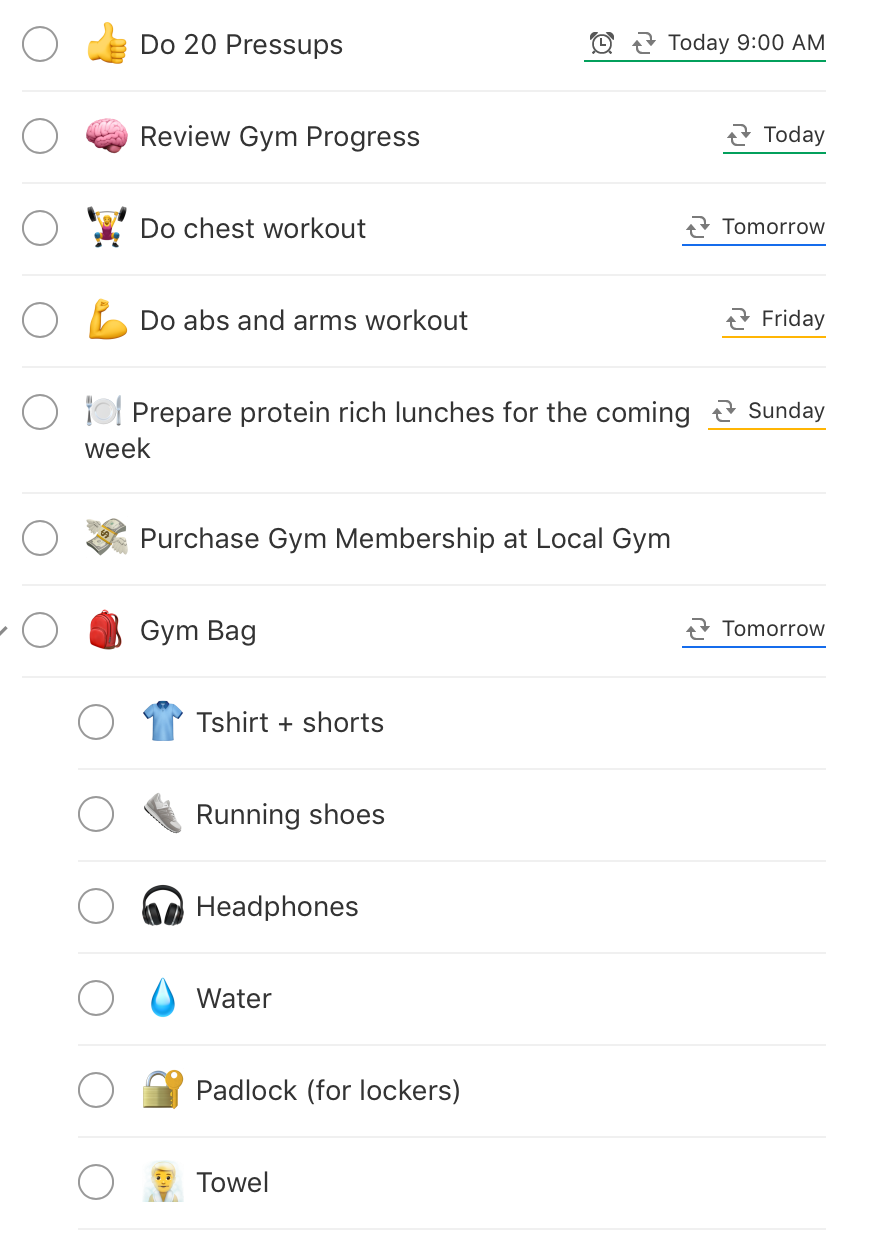However, as with Todoist, I had mixed feelings about how recurring tasks remain in the Inbox tab indefinitely until you delete the task. It makes sense to have a place where you can review your recurring tasks, but their permanent presence in the Inbox makes me numb to the task after a while. Recurring And Repeating Tasks Set Up In Todoist Leave a reply U sing recurring and repeating tasks in Todoist is a great way to save a lot of time and to stay on top of all of your tasks that occur regularly, or at least more than once.
If you need to get things done on a regular basis, chance are you’ve used recurring tasks in todo apps before. These can be useful for simple chores like “Take trash out every Sunday”, or long-term personal goals like “Call Grandma every month”.
While both of these examples are recurring tasks, there’s a key difference between them: do they have a deadline? Taking out the trash is a weekly chore with a hard deadline. It needs to be completed every Sunday. If you take it out Monday, it will sit at your curb until next Sunday. Your neighbors are likely to be none too pleased with your recurring task performance.
- Find answers to common questions and learn how to use Todoist for yourself and your team. Using Todoist; Tasks & Planning; Due dates and times. Did you get the help you need? Log in to give feedback on this article. Stay up-to-date on all things Todoist by following us on social media.
- In this episode, I take you through setting up recurring tasks and how to set up a routines folder to separate put the mundane tasks that do not belong insid.
- Setting up recurring tasks is simple and straightforward, and it’s much easier for me to just pull up my list every day and see what I have to do instead of having to build that list every day. Time is money, after all. The power in Todoist, of course, is the granularity you can use when building your recurring tasks.
Calling Grandma is a little more flexible. Grandma’s probably not expecting you to call precisely every 30th day. Not to mention, either of you could be busy on the day the reminder pops up in your todo list. What’s important here is just that you call her one month after you last completed the task.
If you’re struggling to follow through on a recurring task without a deadline, like “Call Grandma,” then flexible recurrence can be the answer. Flexible recurrence refers to additional scheduling options for your recurring tasks, such as making a reminder contingent on the last time you completed it, and the option to hide the task out of your todo list until it is due again.
Many popular todo apps support flexible recurrence. Being a productivity enthusiast, we tried the top apps to see how they handled it. So which app is best for achieving your long term goals (hint: Amplenote)? Learn how five of the best apps – Amplenote, Todoist, Things, TickTick, and Amazing Marvin – stack up when it comes to helping you follow through on recurring tasks.
Unlike the other four apps we'll review, Amplenote is both a note-taking app and a todo list manager. Amplenote todo lists exist inside of notes and don't have predefined tabs or due dates. This offers more freedom in how you organize and prioritize your lists.
Depending on your preference, you could create one note that is solely dedicated to your todo list, or you could insert todo lists into your notes as you write. You can add links and images to notes and todo lists, or use a note simply for word processing.
Amplenote is also designed with flexible recurrence in mind. You can easily customize a recurring task to hide out of the way until it is due again, helping you avoid clutter and potential numbness to a task. You also receive confirmation when you complete a recurring task, and you can review completed tasks at the bottom of your list anytime.
Click the arrow next to the task to open the Task Details panel (shortcut: ⌘+)
Set Due to when you'd like the task to recur, such as “1 month after complete”
A field named Snooze appears. Select when you’d like the task to reappear in your todo list, such as “1 day before due”
Hide Until helps free up space in your todo list by keeping tasks out of the way until they are due again. It also helps keep you motivated – you get the satisfaction of seeing the recurring task removed from your list each time you complete it.
The task will move to the bottom of the note, separated into Completed Todos. Meanwhile, the next instance of the recurring task moves down out of the way under Snoozed Tasks, and it won't reappear in your todo list until the timeframe you specified previously with Snooze.
Amplenote after completing a task: in the 'Completed tasks' section, with the upcoming instance waiting in the 'Hidden tasks'
As you can see, Amplenote neatly avoids the Inbox tab used by several other apps. This is nice for ensuring you don’t grow numb to a recurring task after seeing it repeatedly.
Bonus: The Completed Todos section contains a small graph to visualize your daily progress through your todos. It’s satisfying (and motivating) to see the graph grow as you check things off throughout the day.
You can easily reschedule the task by opening the Task Details panel again. Under the Due field you’ll see the current due date – click to change it to a future date. If you don’t want to see the task in the meantime, you can also adjust the Snooze date here.
Changing the due date is as easy as hiding the task
I like the ease with which you can reschedule a task and get it out of the way again in Amplenote.

Todoist is a capable app with a variety of scheduling options and cross-platform support. I liked how they offer inspirational templates you can use to organize projects, such as “2019 Goals” and “New Years Resolutions”.
Instead of a typical scheduling menu, you set up a Todoist recurring task by typing a keyword after your task name, followed by a description of your recurrence schedule.
Todoist Every
To set up the task pictured above, you would:
Type “Call Grandma every! month” in the task description
I liked how Todoist lets you set up flexible recurrence with a keyword instead of mouse clicks, but this process wasn't obvious at first. I had to check the Help pages to find the distinction between the keywords every and every! If you leave out the “!” in “every”, the task will recur on a hard schedule, instead of being dependent on when you last marked it complete.
A confirmation appears at the bottom of the screen with a note about when the task will occur again. You can find the next instance of the task sorted logically into the tabs on the left side of the screen.
The notification gave me a sense of accomplishment, which can help sustain long-term progress on todo lists. I also appreciated how the task disappears from immediate view until the time to complete it again gets closer. This helps reduce clutter in your todo list.
You’ll notice that Todoist, like many other productivity apps, has an Inbox tab where a master version of your recurring tasks reside permanently until they are deleted. I find that seeing a task repeatedly for a long period of time can make me numb to it. I learn to ignore the task and it no longer seems important. With this in mind, I find this type of inbox solution to be undesirable for handling recurring tasks in the long run.
Sometimes a recurring task appears but you aren’t able to get to it that day. Ideally, you’d be able to reschedule the task, or take some other action so that you won’t forget until the next time it’s scheduled to recur.
You can reschedule a Todoist recurring task by clicking Edit Task, then selecting from options like Postpone to Tomorrow, or a date further into the future.

Alternatively, if you don’t do anything, the task will be moved into a new section the following day labeled Overdue. I appreciated the simplicity of the rescheduling option, but found that relying on the overdue option led to the same numbness towards tasks that I described earlier.
Things is a sleek todo app that has won awards for its elegant design. One downside is that it is Apple-only, so Windows and Android users will have to look elsewhere. Another downside is that Apple users need to purchase separate plans to use the app on their iPhone, iPad, and desktop/laptop.
The form for creating repeating todos is a little hidden, but still functional.
While the task is highlighted, open the Items dropdown menu from the top of the app and select Repeat
Select your recurrence (every [x] [days/weeks/months/years])
There's an option to add a deadline and start [x] days before it. The start number determines when the task shows up in the Today tab
This Add deadline option is helpful for keeping the task out of the way until the time to complete it gets closer.
The task simply disappears from your todo list. There’s no confirmation that the task is complete, nor that it has been rescheduled.
The minimalist design is appealing at first, but when the task disappears without any confirmation, it can leave you wondering what happened. Where did it go? Is the next one scheduled? Without a confirmation, I didn't feel the same sense of accomplishment I had with other apps.
On the plus side, I appreciated how the task automatically got out of my way until it was due again. Additionally, the recurring task does not remain in your Inbox indefinitely like Todoist (the next recurrence will be located in the Upcoming tab), something that helped prevent me from getting numb towards a task.
You can use the When option to reschedule the task to the evening, tomorrow, or another date in the future.
I found this to be a simple solution that gets the task out of your way again until the rescheduled date. It’s also nice that Things makes it easy to reschedule a task – this is not always straightforward in other apps.
Todoist Recurring Tasks Disappear
Tick Tick offers a solid set of scheduling options that are easy to find, as well as cross-platform support. It lets you share tasks with other people, and if you purchase the premium version, you can track who is completing which tasks on a list. Some teams might appreciate this feature.
It takes more clicks to set up flexible recurrence in Tick Tick than the other apps I tested. On the plus side, the process is still more obvious than Todoist's keywords or Things's hidden panel.
Click to open the task options panel
Click Set Repeat, then select Custom for the timeframe
Click OK on both windows to close them
Like Todoist, TickTick automatically organizes tasks into tabs based on the due date.
When you complete a recurring task, you receive a confirmation that the next recurrence is scheduled, and the completed task is moved to a section under your todo list labeled Completed.
However, as with Todoist, I had mixed feelings about how recurring tasks remain in the Inbox tab indefinitely until you delete the task. It makes sense to have a place where you can review your recurring tasks, but their permanent presence in the Inbox makes me numb to the task after a while.
You can reschedule the task for another date in the future with the same menu used to set up the recurrence. Somewhat confusingly, you now find this menu in the task details panel, instead of next to the task name, where it was located initially.
It's nice that rescheduling is possible, but it did take a moment to figure out where the menu had moved.
Amazing Marvin offers a simplified layout that is focused on showing you “Today”. I liked the friendly mascot that shows you around the app, and they have detailed documentation to guide you towards being more productive. I got the impression that Amazing Marvin really wants to help.
One downside is that the mobile apps are still prototypes, but Amazing Marvin states they will be improving these in the future.
It’s fairly straightforward in Amazing Marvin:
Click the icon Edit Task
Select x days after completion
Click Add recurring task
Note that the only time increment available is number of days, which means you may have to do a bit of math to input weeks or months.
If you’ve set the recurring task to start today, the task will be visible immediately in your Today view after you save it.
The task is moved to a section labeled Completed Tasks on the bottom half of the screen and a new task is generated on the appropriate day. Since Amazing Marvin's interface only shows you one day at a time, this is a simple and neat solution that keeps the recurring task out of the way until it is due again.
If you're busy and need to reschedule a recurring task, I found two different ways to do so in Amazing Marvin, although neither felt ideal to me. You could change the due date of your task to say, tomorrow, by clicking the Edit task icon again and changing the Due Date field.
However, the task remains in the Today view even after you change the due date, taking up space and opening up the possibility of getting numb to the task.
The other option is to pause the task. Choose Recurring Items from the menu in the upper right, and then select the Pause option for a given task. Because this option is fairly hidden, however, you run the risk of forgetting to un-pause the task.
There are important nuances to the way apps handle flexible recurrence. Factors like confirmation messages, “Completed” sections, and the ability to hide tasks out of the way until they’re due again can really help sustain feelings of achievement and momentum towards your goals.
Some concepts that seemed logical initially, such as using an “Inbox” as a master home for your recurring todos, can lead to undesirable side effects. Seeing a recurring task continuously can cause you to grow numb towards it and neglect it when it does recur.
Using recurring and repeating tasks in Todoist is a great way to save a lot of time and to stay on top of all of your tasks that occur regularly, or at least more than once.
When setting up a task in Todoist, to make it recurring you fill out the task information as you normally would, but when it comes to the time / date field you make some small changes.
For example, if you want a daily reminder you would type in “every day” in the date field and it would become recurring every day (remember – every day is ever day, including weekends!). If you only want weekdays you would type in “every weekday”.
There’s lots of date formatting options that gives repeating tasks a lot of flexibility – you can find more of them here on the Todoist date formatting guide.
This is also important to know about if you are using IFTTT and Todoist – you’ll need to make sure you have your date formatting correct or you may run into some real issues.

Another area where date formatting for recurring tasks can come in handy is setting start and end dates.
As an example, let’s say you had a project with a new task that came up, but you only need reminders through the end of the week. If today was March 23 and Friday was March 25, you would type in “every day ending March 25”. You can also do this for starting dates to set up a recurring task in the future!

The post Recurring And Repeating Tasks Set Up In Todoist appeared first on The Productivity Academy.
via http://www.productivity.academy/news/recurring-repeating-tasks-set-todoist/ at The Productivity Academy
